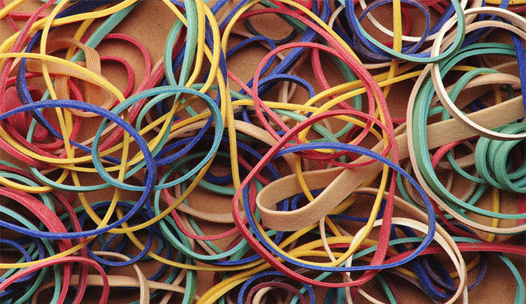Pik India manufactures Rubber bands of standard and premium quality in different single colour like green, red, black, blue in latex natural band to be used in pallets, drums. The other rubber bands application is to be used in conductive and antistatic application. Rubber bands are resistance to temperature and ultraviolet rays, oils, chemical, abrasion, heat, weather. There are other so many applications for rubber bands like printed rubber band, wrist band. In spite of above rubber band we can manufacture and supply other bands and as per customer requirement.
Sometimes what is a rubber band might not even seem like a rubber band. In armbands, sleeves, (1) shower caps, respirator masks, (2) eye protection devices, sweat pants, (3) glove cuffs, disposable medical items and many other articles.
You can easily measure the force produced by a drastically stretched rubber band. Rubbery materials act like simple springs when they're not deformed too much. Following the relation known as Hooke's law, a 10 percent increase in stretching force will make a typical rubber band 10 percent longer. But when rubber materials are stretched to twice their original size or more, that simple linear law fails.
Rubber is made of flexible long-chain molecules tied together in places by bonds known as crosslink’s that connect atoms in adjacent chains. The arrangement looks like strands of spaghetti stuck to each other at random points. Physicists describe rubber's tendency to return to its original shape using the laws of entropy, or disorder. A chain molecule that's fully stretched has just one way to arrange itself, as a straight line, while an unscratched chain can ravel up in many possible ways--corresponding to a state of higher entropy. Stretched rubber snaps back to its original state to maximize its entropy, as thermodynamics demands.
The classical theory of rubber elasticity, developed in the 1940s, adds together the entropies of the free sections between the fixed crosslinks. The theory assumes that, as the rubber is stretched, each crosslink remains stationary--stuck to its local chunk of rubber--even as the chains between crosslink’s jiggle around. The jiggling is driven by heat, the usual driver of molecular motion.
The new theory gives a nonlinear relationship between force and stretching that closely matches rubber's known properties. "This elegant paper makes the simple point, remarkably missed until now, that fluctuations of the positions of the crosslinking points also contribute" to the forces associated with deforming rubber. These corrections fit experimental data much better than the classical theory.
The team says their theory should apply to a wide range of soft elastic materials, and they are devising experimental tests that will show whether the new source of entropy is truly the crucial ingredient. For example, the chemical treatment known as "swelling" takes away rubber's incompressibility, which should remove much of the additional entropy, according to the new theory. That should bring the material's behavior into closer agreement with the old theory.
Secret of Rubber Band
Q1 : What is rubber band made of?
A1 :
Main material is "rubber", usually natural rubber, but some types of synthetic rubber are also used to obtain certain specific quality depending on the application. Besides, fillers such as calcium carbonate, carbon black, clay and additives like sulfur, stearic acid, zinc oxide, wax, oil, accelerators are mixed into rubber as ingredients.
Q4 : How was rubber band invented?
A4 :
It is believed that long-long ago, someone happened to cut an old bicycle inner tube for tying certain object, and then others found it very useful and convenient even though it was not as elastic as today's rubber band. Eventually commercial production commenced with right formulation by business minded people.
Q5 : Why rubber has to be vulcanized?
A5 :
Natural rubber itself is soft, less resilient, broken down easily when over stretched and not able to return to the original shape after being stretched. Moreover, it is easily damaged by heat, sunlight, oil, oxygen and solvent. During a process called vulcanization, the sulphur molecule becomes a bridge between rubber molecules and forms a three dimensional network with help of other ingredients (just like fishing net made of many lines of thread). This network improves the above weaknesses of natural rubber for practical use. Generally, the higher the rubber content, the higher the resilience and elasticity.
Q6 : What is happening inside rubber during vulcanization? A6 :
At the vulcanizing temperature (practically, 140-200°C)., a complex chemical reaction starts to occur and leads to the formation of sulphur crosslink as shown schematically below, a, b and c denote the number of sulphur molecules which range from 1-6. X denotes the residual of accelerator.
Q8 : How should rubber band be stored?
A8 :
Products made of natural rubber are, in general, aged faster by exposure to heat, air and sun light. Therefore, rubber bands should be packed, preferably in air tight bag or container, and stored in cool and dark place for securing longer life.
|
